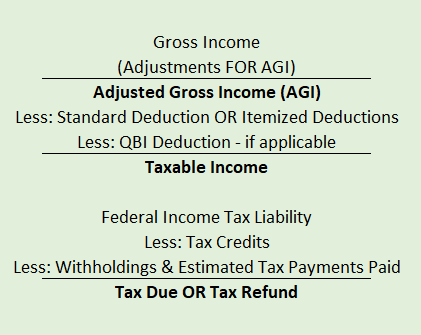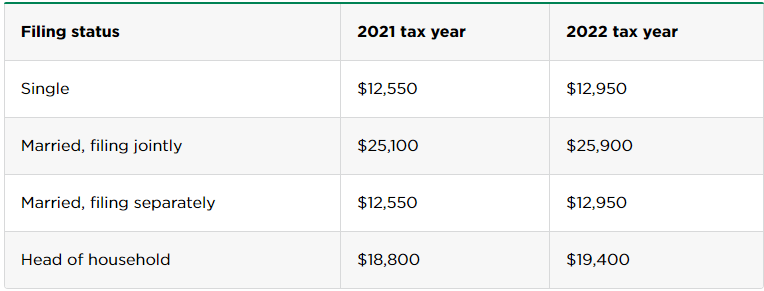Unfortunately (or fortunately), we’re not all tax specialists. Despite this, ultimately the responsibility for attesting to the accuracy of a tax return rests with the taxpayer, not the tax-preparer. This article outlines some key items to review before signing off on your tax return and where to find the needed information. Whether you prepare your own taxes or pay a specialist to do so, it’s helpful to be aware of the basics.
Quick Overview of Tax Returns
Tax Form 1040, which is the tax return for individuals, includes the following basic sections and example items (this is not a complete list):
1. Form 1040 – Individual Income Tax Return – all subsequent items flow into Form 1040
Link to the 2021 Form 1040: https://www.irs.gov/pub/irs-pdf/f1040.pdf
2. Form 1040, Schedule 1: Additional Income and Adjustments to income
Includes: Adjustments FOR AGI such as contributions to qualified retirement plans
3. Form 1040, Schedule 2: Additional Credits and Payments
Includes: Self-Employment Tax, Household employment tax, IRS penalties
4. Form 1040, Schedule 3: Additional Credits and Payments
Includes: Education, energy, foreign tax, and dependent care expense credits, etc.
5. Schedule A: Itemized Deductions
6. Schedule B: Interest and Ordinary Dividends
7. Schedule C: Profit or Loss from Business (sole proprietorship)
8. Schedule D: Capital Gains and Losses
Calculating Your Tax Liability
Your tax liability is calculated as follows:
Adjustments subtracted from Gross Income are known as Adjustments FOR AGI (Adjusted Gross Income). Some of the most common adjustments FOR AGI include pre-tax contributions to qualified retirement accounts (IRA and employer retirement plans, including self-employed retirement plans), limited student loan interest, and one-half of self-employment tax. AGI is important because it is used as the basis for many phase outs for other deductions and credits.
Take the Standard Deduction or Itemize?
Once AGI is known, taxpayers choose to either take the Standard Deduction or to Itemize their deductions. The standard deduction is available to all taxpayers based on their tax filing status, with increased deductions for taxpayers age 65+ and taxpayers who are blind.
For the 2021 tax year, the standard deduction is $1,350 higher for those who are over 65 or blind; it's $1,700 higher if also unmarried and not a surviving spouse. For the 2022 tax year, it's $1,400 higher for those over 65 and $1,750 higher if also unmarried and not a surviving spouse. Due to the increased standard deductions under the Tax Cuts and Jobs Act of 2017, most Americans now take the standard deduction.
To determine whether or not to itemize deductions or to take the standard deduction, you must calculate your itemized deductions and choose the larger of the two deduction totals. If you have mortgage interest, pay property taxes, donate thousands of dollars to charity, or have large medical expenses, itemizing may be your best option. If these do not apply to you, you will likely take the standard deduction.
AGI minus the standard or itemized deduction amount minus any Qualified Business Deductions (for some self-employed individuals only), equals taxable income. Tax bracket values are based on your Taxable Income with consideration for your capital gains. You must calculate any capital gains for the year before arriving at your tax bracket.
You may note that long-term capital gains are included in taxable income on line 15 of Form 1040, but are taxed at lower capital gains rates. This is true and a separate worksheet called the “Qualified Dividends and Capital Gains Worksheet” is used to separate ordinary income and capital gains to calculate the total tax amount on line 16 of Form 1040. Long-term capital gains rates are distinct from your ordinary income tax rate.
Things To Look Out For
1. Compare your tax liability and line items from the current year to the previous year return and note any large differences. Try to understand the differences or ask your tax preparer.
2. If you decide to itemize, make sure that the amount listed on Form 1040, line 12a, is greater than the standard deduction.
3. If you are age 65+ and/or blind and taking the standard deduction, make sure your standard deduction is increased for the additional deduction allowed for those groups.
4. Most states allow you to take the standard deduction on the Federal return and still itemize on the state return. Know what your state’s rules are and which combined method makes sense for you.
5. If you itemize, review Schedule A where your itemized deductions are broken out. Ask your tax preparer questions if you don’t understand what’s being included.
6. If you are due a refund, evaluate the withholding amount you have elected on your paychecks and/or investment income/RMDs and determine if you should decrease withholding in the future. If you owe a significant amount, consider increasing your withholding amounts. It is possible to be penalized for insufficient withholding or insufficient estimated payments.
Note that estimated payments are required for taxpayers who expect to owe at least $1,000 in taxes in addition to withholding. In order to avoid penalty, make sure your withholding and/or estimated payments are equal to the lesser of 100% of the prior year tax liability or 90% of the current year liability. If your taxable income is greater than $150,000 then estimated payments plus withholding must equal 110% of prior year liability.
Common Forms/ Schedules:
Form 1099: If you have a brokerage account, your custodian will provide a Form 1099 likely in late January - mid February. This form will show any gains and losses for tax purposes that should be included in Schedule D which flows into line 7 of Form 1040. Look over your Cost Basis information and watch out for zeros or missing information.
Form 1099-R: If you have taken distributions from a retirement account, Form 1099-R will indicate your taxable distributions which must be included in your tax return in lines 4a, 4b, 5a, and 5b. Any tax withholding will also be reported here.
Schedules A, B, D: These are popular forms for W-2 taxpayers with investment accounts. Descriptions are listed above.
Please note that with more complicated tax returns, there is a long list of possible Forms and Worksheets that will need to be filled out. This article is meant to provide a high-level overview for basic tax returns and describe where to find the most common information needed.
While we don’t prepare taxes at American Money Management, our team of financial planners are happy to review your prior year tax returns as part of our financial planning process.





